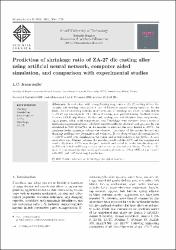Prediction of shrinkage ratio of ZA-27 die casting alloy using artificial neural network, computer aided simulation, and comparison with experimental studies
Künye
Kumruoǧlu, L.C. (2021). Prediction of shrinkage ratio of ZA-27 die casting alloy using artificial neural network, computer aided simulation, and comparison with experimental studies. Scientia Iranica, 28 (5 B), pp. 2684-2700.Özet
In cast alloys with a long freezing range such as ZA-27, casting defects like porosity and shrinkage may occur in case of failure to control casting variables. In this study, the role of casting variables in the formation of shrinkage and micro-porosity defects in ZA-27 was investigated. The defects of casting were predicted using Artificial Neural Network (ANN) algorithms. To this end, cooling rate, solidification time, temperature, liquid phase, initial mold temperature, and %shrinkage were obtained from a series of simulation-experimental tests. The heat transfer coefficient of ZA-27 and graphite die was calculated as 2000 W/(m2K). In the samples poured into the mold heated at 350°C, the minimum feeder shrinkage volume was observed. Locations of the chronic hotspot and shrinkage problem were determined and evaluated. It was observed that the casting heated to 150_C caused deep shrinkage on the upper and lateral surfaces of the feeder. A good correlation was obtained between the modeling results of the ANN and the experimental results. Optimum ANNs were designed, trained, and tested to predict the shrinkage rate at different initial mold temperatures and in various physical conditions. Thanks to the sigmoid (sigmoaxon) function training, the most systematic modeling ANN set was revealed with 99% (vol. 7.65%shrinkage) prediction.
















